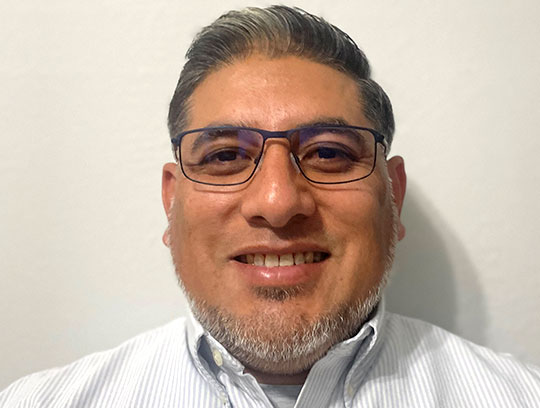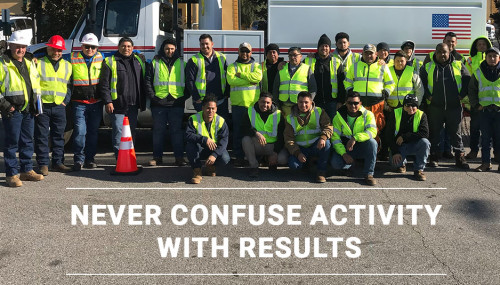“How’s life?” Busy.
“How’s work?” Really Busy.
“How’s everything else?" Too busy.
These seem to be the increasingly common replies given when people are asked how they’re doing—responses often accompanied by a shake of the head, eye roll, or even a defeated sigh.
Daniel Sandoval, Lewis’ Division Manager who oversees teams in Alabama, Georgia, Tennessee and Mississippi, understands what it means to be busy—however, he doesn’t default to standard responses.
“We’re always going to be busy,” Sandoval states. “But ‘being busy’ is not the point. The real focus should be the results of our efforts. We need to ask ourselves, are our actions aligned with our objectives and driving us toward our intended goals—or are we expending effort without delivering results?”
With more than 22 years of experience in vegetation management, Sandoval has learned how to differentiate between being busy and being productive. He knows that a flurry of activity does not necessarily translate to meaningful results. When asked what turns activity into results, Sandoval points to strategy. “Working from a strategic plan keeps our teams focused and moving in the same direction—especially when unexpected circumstances arise.” And in an industry with frequently changing conditions and risks, Sandoval has seen how plans can pivot very quickly.

Pivoting with Purpose
A critical component of leadership is creating a plan with clear objectives, then working that plan. Leaders also know that even the best-laid plans can change very quickly. An unexpected absence, trouble with equipment, dangerous weather, or an urgent request from a customer can swiftly lead to unanticipated changes in plans and even priorities.
Sandoval notes, “We are really good at reacting when changes occur—which can definitely keep us busy—however we also have to be good at standing back, looking at the big picture, and thinking strategically about success. You can’t allow unexpected circumstances to allow you to take your eye off your goal.”
Sandoval believes in the power of repetition and compares his communication style to a beating heart that continuously pumps out messaging
Success at Lewis is defined and executed in very specific ways. Success is the fulfillment of the Customer Promise to listen, develop solutions, and meet commitments. Success is the delivery of a Job Done Right® and a professional, hassle-free experience. Success is the consistent demonstration of Lewis’ Operating Principles.
And while success is focused on delivering the best customer experience, for Sandoval, success is also making sure that his teams go home safely every night. Sandoval strongly believes that results and safety go hand in hand, which sometimes means making difficult or unpopular choices and pivoting as needed. “We’re always striving to be productive, to be focused, to be on-task,” Sandoval explains. “However, there are times when conditions are no longer safe and we might not complete that task or finish that tree today. That’s not being lazy—that’s being purposeful about priorities and protecting the safety of our teams.”

Role Conflict

Division 34 Manager Daniel Sandoval
Humans are multi-faceted and hold various roles in their lives. During the course of a day, we can be parents, professionals, friends, teammates, spouses, partners, and more. With each role, we have different responsibilities and interactions. Some of these roles come easily, allowing us to move effortlessly between each. However, there are times when roles are unclear or in conflict.
In her article “What is Role Conflict in Sociology”, Ashley Crossman explains that sociologists use the term “role” to “describe a set of expected behaviors and obligations a person has based on his or her position in life and relative to others.” Roles guide behavior, affect interactions, and even set expectations.
So what happens when someone doesn’t understand their role or is unclear about what’s expected of them? Instinctively, many people keep their heads down and try to “look busy”. For Sandoval, this behavior prompts the question WHY? Are they uncomfortable with a task because they don’t feel prepared or proficient? Are they afraid of speaking up because they don’t feel safe admitting their uncertainty? Were the directions or expectations not clear enough?
When Sandoval sees that a crew member seems conflicted about their role, he commits to finding out why. “As a leader, it’s my responsibility to assess the situation and figure out what’s not working—then create a plan for moving forward. If employees are feeling insecure about their role and responsibility, it’s an opportunity for more training and mentoring. If they’re afraid to speak up for fear of ridicule or rebuke, then there’s a culture issue that needs to be addressed. And if they still don’t understand what’s being expected of them, it’s time for R&R: reiterate and repeat.” Identifying and knocking down these barriers can often be the difference between busyness that is unproductive and re-engagement that focuses team members and fosters an improvement-minded culture.

A Steady Heartbeat of Messaging
Sandoval believes in the power of repetition and compares his communication style to a beating heart that continuously pumps out messaging. “It’s important for the end result to be clear, but the plan for getting there must be understood as well,” Sandoval insists. “There needs to be a steady stream of reiterate, reiterate, reiterate.” Sandoval is an advocate for short, simple messaging. He strives to keep his instructions concise and encourages his teams to write down details for future review. “When people are clear on what’s expected of them, they stay aligned and productive. And they’re less inclined to appear busy just to look productive.”
In addition to consistent communication, Sandoval points to trust as the connective tissue that keeps everyone linked. “Trust and respect are the building blocks for strong teams. I can’t be everywhere at the same time, so I need to trust that my teams are doing what needs to be done—that they’re being productive and not just busy.” That trust goes both ways. Sandoval continues, “My teams need to be able to trust me, too. They know they can ask me to step in and call a customer when we need to solve a problem or change course. Sometimes goals and related plans need to be modified due to changes in circumstances, but even when this happens everyone needs to focus on the target. You can’t let a detour in the road allow you to go completely off course.”
For Sandoval, it’s all about being accountable to customers, crew members, and fellow employee-owners. “If we seek to improve every day and have our efforts aligned to the results we’re shooting for, like a medal-winning Olympic athlete we have the best possible chance of succeeding at the end of our journey.”
As a leader, it’s my responsibility to assess the situation and figure out what’s not working—then create a plan for moving forward.








